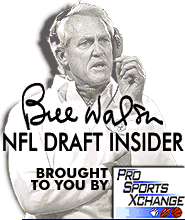
How I Evaluate Each Position:
Guard
By Bill Walsh
PSX Draft Insider Special
|
|
How I Evaluate Each Position: Guard By Bill Walsh PSX Draft Insider Special |
GUARD
Ideal size: 6-3, 300
The guard is going to have to be styled with the system of offense you have or the offense must be styled as to who the guards are. Typically, you style your offense in relation to who you have at the guard positions. You have to adapt your style to your guards.
Again, the great athletes can do everything -- quickness, agility, explosion, ability to pull and trap and mobility to go inside out on the linebacker. There are those in the game today; Randall McDaniel of Minnesota is that type. He probably plays at no more than 280, but he is an outstanding player in every sense.
As a pass protector, the guard usually can get help. He just has to have enough power not to get knocked back. He will be helped just by the sheer number of people inside. So he can get away with a shortfall as a pass blocker as long as he has the girth so the defensive tackle cannot pick him up and move him. He could be a man who presses 500 pounds and still get moved out of the way very quickly.
Guy McIntyre was an example. He was very athletic, but they were able to pick him up and move him. On the other hand, we had a guard named John Ayers who was almost impossible to move although he wasn't as athletic as McIntyre. So that girth and stability and body balance is critical.
There is less technique for the guard in pass protection than there is for the tackle. But the guard, on the other hand, is used on many blocking combinations where he must get from point A to point B, pulling through a hole, trapping, pulling on sweeps, coming inside-out on a linebacker blitzing, as Ayers did so effectively against Lawrence Taylor in some epic battles in the early 1980s.
So technique, agility and mobility is important for the guard.
Teams must adapt what they do to fit the abilities of their guards, even if we are talking about whether something can or cannot be done to the right or left. If the left guard can pull and trap, then you are going to run most things to the right with that left guard pulling. You personalize the guard positions as to what they can do. Typically, one or the other is stronger or weaker in technique or ability to get the job done.